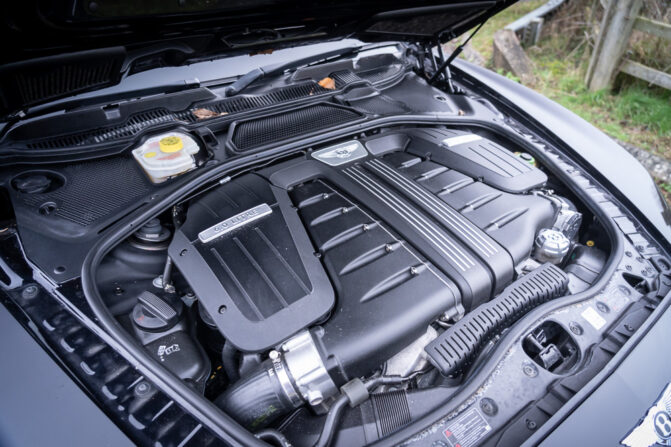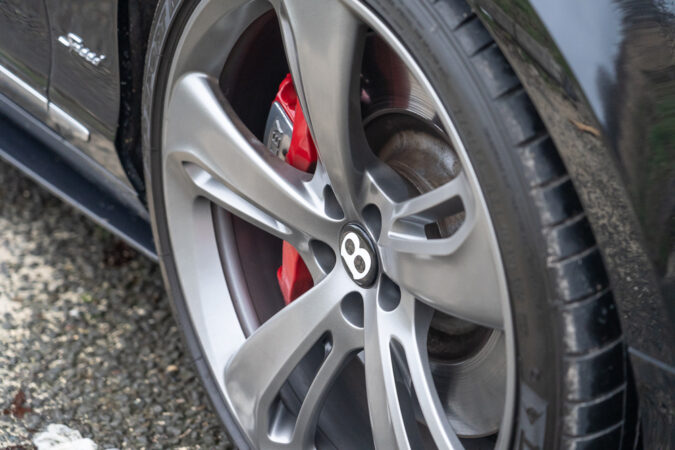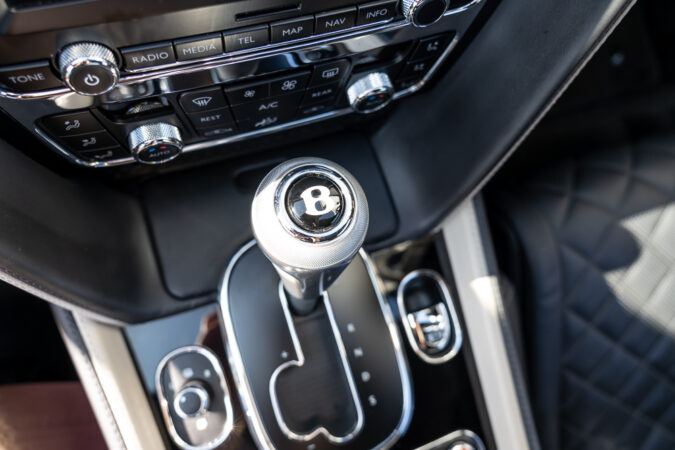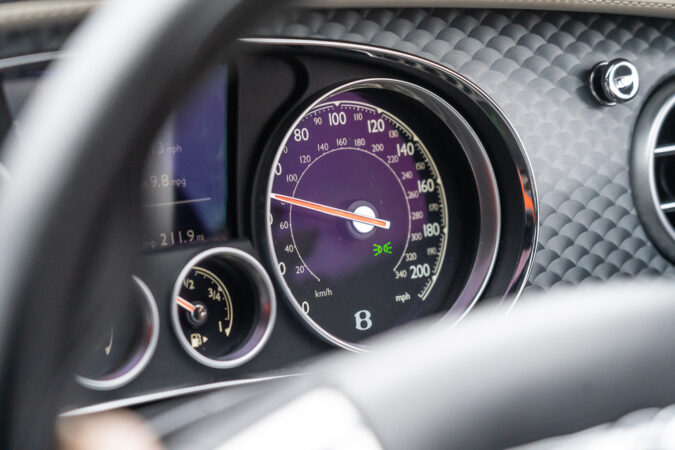If you’ve checked out my preview of Motor Verso’s latest and newest project car in our fleet, a stunningly sumptuous, monolithic, and speedy 2016 Bentley Continental GT, I mentioned that it wasn’t necessarily a terrible idea to be a tad over-paranoid when it comes to getting an aftermarket warranty with it.
There’s a good reason why folks tend to attach a big “AVOID AT ALL COSTS” sign when it comes to buying old luxury cars. It’s not just Bentleys either (which I bought from the great folks at Auto100), but you could say the same for Rolls-Royces, Mercedes Benz, BMWs, Audis, Maseratis, Jags, and so on. They depreciate like a rock in the used market for a reason.
They’re cheaper to buy second-hand, and on the surface, it might seem like you’re getting a good deal, with soft leathers, premium trim, lambswool carpeting, and bleeding-edge tech (for its time, anyway). But, if (not when) these fail or break, it could sometimes cost you more than the cost of the entire car to fix.
With our fleet’s new 2016 Bentley Continental GT, yearly servicing alone costs around £800, without even taking into account serious problems that might come my way. Meanwhile, faulty components or regular wear and tear for some of the more complex parts on it could easily run in the four to five-digit figure.
How Much Would Repairs & Servicing Cost Me
From some of the figures that I’ve found quoted by other owners; £3,000+ for a new head gasket, £5,000+ for a transmission rebuild (or £11,000+ for a new transmission altogether), £10,000+ to fix sticky valves (a pretty common issue on some older Bentleys), or at least £4,000+ to fix any power steering problems.
In addition, I’d also have to account for £5,000+ for a replacement AC compressor, and god forbid the 6.0-litre turbocharged W12 engine fails entirely, because that could easily cost me £26,000+ for a new engine. Even relatively smaller fixes, like a radiator repair or a replacement window motor, will cost £1,000+.
So, as you can imagine, some of these figures for regular servicing and repairs (including parts that would suffer the same or similar rate of wear and tear on other cars) are eye-watering. This is the quintessential reason why a good warranty is a must for cars like these, as they can alleviate a lot of the financial burden.
However, what do you do when the factory-backed warranty no longer applies or can no longer cover a particular car (like my Bentley)? Well, the answer is simple; get an aftermarket warranty. However, there are loads of aftermarket, third-party automotive warranty providers here in the UK, so how do you choose?
After doing some searching about and comparing between some of the top options, I’ve finally settled on Warrantywise, which claims to offer the most comprehensive warranty coverage for used cars, such as the 2016 Bentley Continental GT that’s since joined our fleet. Some of their features are quite appealing.
These include a huge amount of coverage for most of the Bentley’s complicated mechanical and electrical components, such as the engine, turbocharger, transmission, drivetrain, differential, suspension, steering parts, brakes, fuelling system, cooling system, electronics, seals, gaskets, drive belts, and loads more.
Why A Warranty Is A Must (For Cars Like These)
But, before I delve deeper into what my Warrantywise coverage and warranty plan includes, and why I’m more than happy to have a comprehensive financial safety net over the Bentley, I thought I’d give you my top-3 reasons why an aftermarket warranty is a must if you’re getting an older used car like it, or for old luxury vehicles like the Continental GT:
1. Added Peace Of Mind
Aftermarket warranties give older used cars a new lease on life, as owners can more confidently go into a second-hand vehicle with the peace of mind of knowing that any problems are covered under warranty.
This alone can massively help more people feel more comfortable shopping around for used cars, knowing that those repair costs are compensated (either completely or mostly depending on your specific warranty terms and conditions) by the warranty provider.
For cars like this Bentley here, that might come out to hundreds, if not thousands of pounds in savings for me. That peace of mind alone, for me anyway, is well worth the yearly and monthly premiums for an aftermarket warranty.
2. Limiting Your Financial Downsides
Moreover, aftermarket warranties allow you to minimise and limit your expenses to however much you’re paying in monthly or yearly premiums. For example, my Warrantywise plan for the Bentley would cost me £174 per month in premiums. Yet, that specific Warrantywise plan can otherwise cover up to £5,000 for a single repair job.
As such, if I ever needed to replace the clutch, rather than paying £3,000+ out of pocket, Warrantywise would cover those repair or replacement costs, and my financial downside would thus only be limited to my agreed warranty premium.
(Of course, this does depend on how much your specific warranty covers, and Warrantywise is pretty generous, in this regard). On top of that, another benefit here is that it makes managing your finances more predictable, as you’re less likely to be blindsided by costly repairs.
3. Nice-To-Have Perks And Conveniences
Additionally, I’d be remiss to not at least highlight some of the nice, quality-of-life perks and goodies that Warrantywise offers in return. These added conveniences further make aftermarket warranties an even more compelling value for money.
For instance, besides covering the costs of acquiring spare parts for repair or replacement jobs, Warrantywise also compensates the labour hours associated with performing those repairs. In my case, my specific Warrantywise plan could help pay out up to £150 per hour for labour fees to the garage or workshop that I send the Bentley to.
Furthermore, Warrantywise has some extra nice-to-haves beyond that, such as a 24/7 vehicle recovery assistance, helping you get a car hire, or cover for the hotel or travel expenses that you might’ve accrued if you were left stranded by your car.
What Sorts Of Plans Does Warrantywise Offer
One thing to bear in mind, is that Warrantywise offers five separate plans and levels of coverage (though, the specific pound amount of coverage may vary from one car to the next, even when you’re within the same plan). So, for added context, here’s a quick look at the five plans that Warrantywise offers:
- 04/40 Plan (Platinum Plus) – Vehicles up to 4 years old and have under 40,000 miles
- 06/60 Plan (Platinum) – Vehicles up to 6 years old and have under 60,000 miles
- 08/80 Plan (Gold) – Vehicles up to 8 years old and have under 80,000 miles
- 10/100 Plan (Silver) – Vehicles up to 10 years old and have under 100,000 miles
- 12/120 Plan (Bronze) – Vehicles up to 15 years old and have under 150,000 miles
With that aforementioned 2016 Bentley Continental GT project car (which, no doubt, I’ll write more about in the coming weeks and months), I’ve been offered Warrantywise’s 08/80 or ‘Gold’ plan, given that it has fewer than 80,000 miles on the odometer, and at the moment, it’s a smidge over 7 years old.
So, as you can see, the plan that Warrantywise ultimately is able to offer for your car is dependent on two factors; 1) how old it is, and 2) how many miles it’s driven. The general rule of thumb applies; the older the car is, and the more miles it has under the belt, the more likely it is that something somewhere will require replacements or repairs. As to what components they’re able to cover, I’ll discuss more of that below.
What Parts Of The Bentley Does Warrantywise Cover
Specifically, when looking at Warrantywise’s 08/80 (Gold) Plan, the amount of coverage that you’ll get (as have I) is actually pretty comprehensive. Here’s a quick summary of what components or parts of your car could be subjected to warranty coverage (bearing in mind, that your specific plan might vary slightly).
So, here are some of the common automotive parts, components, and systems which Warrantywise could cover in case of failure (including with the Bentley):
- Engine – This mostly includes coverage for all the major moving parts in your car’s engine, such as your car’s crankshaft, camshaft, pistons, connecting rods, balance shafts, gears, oil pumps, variable camshaft timing systems (VANOS), chains, sprockets, tensioners, cylinder head, engine block, and liners. (Although, bear in mind that it won’t cover burnt-out valves or valve seats).
- Turbocharger Or Supercharger – This includes coverage for all moving parts (not including oil seals) related to your car’s turbocharger or supercharger wastegate or intercooler.
- Transmission (Manual Or Automatic) – It’s inclusive of coverage for all the mechanical and electrical components within your transmission or gearbox, transfer case, torque converter, and overdrive system. (Although, you’ll have to bear in mind that it won’t include coverage for the hydraulic actuator, oil cooler or radiator, as well as any mechatronic units and the valves).
- Clutch – As an extension of the previous point, this means coverage for your flywheel (including a dual-mass flywheel), flex plate, pressure plate, centre plate (though, this won’t include any worn-out facing materials), ring gear, release bearing, master cylinder, slave cylinder, fork lever, clutch pedal, and the clutch cable.
- Drivetrain – This relates to coverage for your car’s driveshafts, prop shaft, centre bearings, constant velocity joints, universal joints (not including the rubber boots), as well as the couplings.
- Differential – It includes coverage for the crown wheel and pinion, and all other internal mechanical moving parts in your car’s differential.
- Suspension – That means coverage for your car’s wheel bearings and cages, coil and leaf road springs, pneumatic air springs, shock absorbers, ride height actuators and their regulator valves, wishbones, track control arms and linkages, suspension pump, kingpins, ball and swivel joints.
- Steering – This entails coverage for your car’s rack and pinion, steering box, power steering rack and pinion, power steering box, pressure pipes, idler box, hydraulic and electrical power steering pumps, steering fluid reservoir, steering column joints and bearings, as well as the track rod ends.
- Brakes – Furthermore, Warrantywise allows coverage for your car’s braking servo, master cylinder, wheel cylinders, brake callipers, vacuum pump, pressure restrictor valve, brake pedal, handbrake lever and cable, and brake discs or drums.
- Anti-Lock Brakes – For your car’s ABS system, the 08/80 (Gold) plan further includes coverage for your car’s electronic control unit, ABS pump, actuator, modulator, and wheel sensors.
- Fuel System (Petrol & Diesel) – Here, this means coverage for your car’s lift pump, fuel pump, injection pump, injector, heater or glow plug, fuel level sender unit, throttle body, throttle potentiometer, airflow meter, air flow sensor, cold start valve, regulator, overrun cut off valve, fuel accumulator, fuel pressure regulator and fuel injector wiring loom.
- Cooling System – It includes coverage for your car’s radiator, engine oil cooler, heater matrix and heater fan motor, water pump, cooling fan motor, viscous cooling fan coupling, thermostatically controlled radiator fan motor, engine temperature sensor, engine temperature gauge, thermostat and thermostat housing.
- Electrical System – This means it will cover your car’s electrics, such as the starter motor, alternator, voltage regulator, ignition coil, camshaft and crankshaft sensors, indicator relay, front and rear windscreen wiper motors and washer motors, electric window regulators and motors, sunroof and cabriolet motors (including the switches), a central locking mechanism (excluding the locks, barrels, keys and key fobs), cruise control unit, headlamp motors, heater fan motor, thermostatically controlled radiator fan motor, horn, multi-function indicator stalk switch, alarm control unit and siren. Another component that it covers is your car’s engine control unit and body control unit.
Some Other Goodies & Perks That Warrantywise Includes
Oh, but we’re not even done, yet! Warrantywise, besides the already in-depth and comprehensive level of coverage that I mentioned earlier in the 08/80 (Gold) plan, also includes coverage for some other parts of your car, which goes on top of the ones I highlighted earlier:
- Oil Seals – This includes coverage for your car’s engine and transmission oil seals (which might otherwise cause major oil leaks or dripping), which would mostly warrant an immediate replacement, and in those instances where extensive removal or disassembly is required to fix it.
- Gaskets – That includes covering your car’s cylinder head gaskets.
- Drive Belts – Mainly, coverage for your car’s camshaft timing belt.
On top of that, Warrantywise has it so that they offer coverage for certain components and parts of your car to be replaced in pairs. This includes parts like your car’s brake discs, brake drums, coil springs, and shock absorbers, among others. These are the sort of parts that, normally, you will replace them in pairs (even when only one has failed), as a matter of good practice and to ensure optimal and reliable performance.
Optional Coverage That You Could Include
One more thing to take note of with Warrantywise’s aftermarket warranties (which are also familiar with the other warranty providers on the market) is that they offer optional coverage for certain components. This goes on top of the default coverage that I’ve listed up above, but optioning these will cost you more.
Therefore, you’ll have to weigh on whether these options, which Warrantywise refers to as ‘Additions’, are worth it for you or otherwise. For instance, Warrantywise has a specific add-on coverage which is tailored specifically for electric cars. Naturally, if you don’t own or drive an EV, it’s pointless to add this option.
Here’s a quick summary of what Warrantywise offers as optional coverage that you could consider adding on top of the default coverage (I’ve summarised it pretty briefly here, so check out my detailed write-up on what sort of optional extra add-ons you could consider when picking an aftermarket warranty):
- Airbag warning systems
- Air conditioning components
- Driver assistance features and ADAS suites
- Electric vehicle-specific components
- Emissions control components
- Parts that cause an MOT failure
- Multimedia systems
All in all, I’m pretty impressed by how generous Warrantywise’s level of coverage is, as well as the options they give to customers to tailor and suit each plan just for them and their cars. For now, thankfully, not a single thing has gone wrong on the Bentley yet, but if or when they do, I’d expect this to come in handy.










